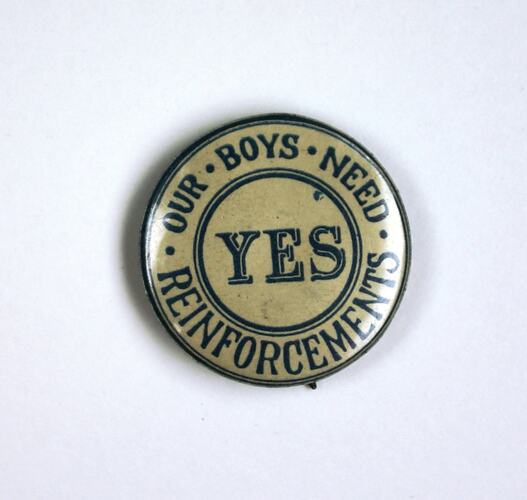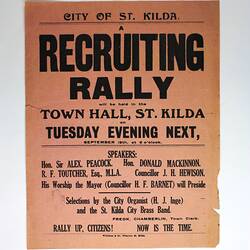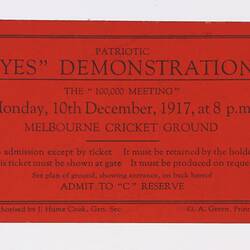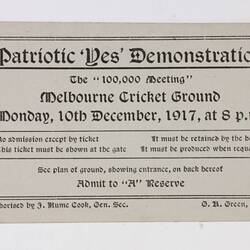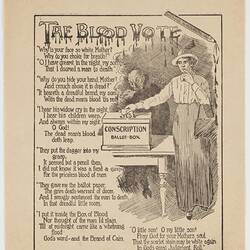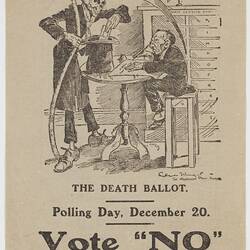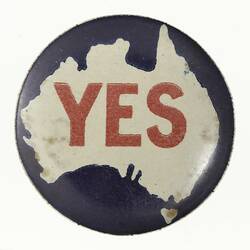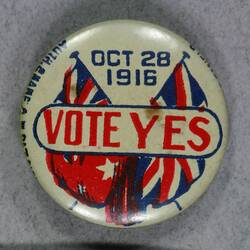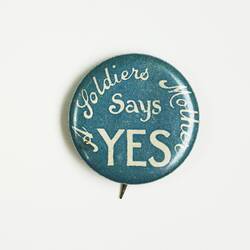Summary
Lapel badge or button, 'YES - OUR BOYS NEED REINFORCEMENTS'. Associated with the unsuccessful 1916 or 1917 referenda to introduce conscription into the Australian armed forces for overseas service. Made by A.E. Patrick, 94 Wilson St, Newtown, Sydney.
While the Australian Government could compel domestic service, men could only be sent overseas if they volunteered to do so. By 1916 this led to a shortage of reinforcements for the front. Prime Minister Billy Hughes attempted to resolve the matter twice by referendum: once on 28 October, 1916 and once on 20 December, 1917. Though both votes were close, both referendums ultimately failed. The debates surrounding conscription proved highly divisive both amongst the general public and within the Labor Party. As a result of the failed 1916 referendum, Hughes left the Labor and started the Nationalist Party.
Physical Description
Circular pressed metal badge with a plastic covered obverse, and a metal back with an attached pin. On the obverse, text printed in blue-green ink on a cream background. Center of badge has the word 'YES' printed in block letter surrounded by a double line border; both in blue-green ink. Remaining inscription printed in a circle outside the border. There is a small inkstain inside the border under 'NEED'. White maker's text appears on the bottom rim. The metal back & pin are tarnished. Some light scratching on the rim.
Significance
Statement of Significance
In 1916 and 1917, in an attempt to increase the number of reinforcements at the front, the Australian Government conducted two referenda to allow conscription for overseas service. The public debates for these referenda were divisive, drew large crowds to rallies and meetings and ultimately caused a split in the Labor Party. Both referendum failed, though the votes were close and front-line Australian forces remained volunteer-only for the duration of World War I.
This badge, from the pro-conscription side of the campaign, highlights the emotive quality of the debate. While some other badges simply urge a 'yes' vote, this example ties that vote to the needs of 'our boys' invoking patriotism and association with those already serving. Objects from these campaigns demonstrate that the Australian public was not always unified in their view of how the war should be conducted or their troops deployed. The homefront was the location of debate and discussion, not simply mute acceptance.
More Information
-
Collecting Areas
-
Acquisition Information
Purchase from Grahame Foster, 06 Mar 2013
-
Maker
A.E. Patrick, 94 Wilson Street, Newtown, Greater Sydney, New South Wales, Australia, 1916-1917
Dates based on the two years of major conscription debate and referendums in Australia. -
Inscriptions
Printed, obverse, blue-green ink,'-OUR-BOYS-NEED- / REINFORCEMENTS / YES' Printed, bottom rim of the badge, 'A E PATRICK MAKER 94 WILSON ST NEW OWN, SYD'
-
Classification
-
Category
-
Discipline
-
Type of item
-
Overall Dimensions
3 mm (Depth), 22 mm (Outside Diameter)
-
Keywords
World War I, 1914-1918, Referendums, Badges, Conscription, Political Rallies
